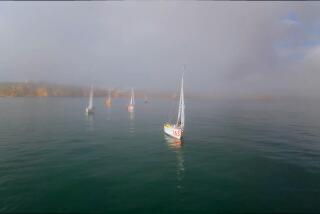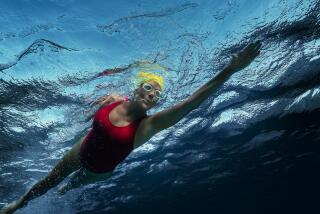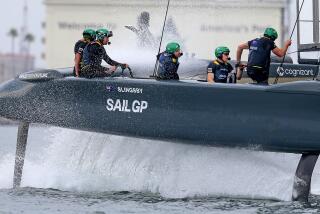The Cutting Edge: COMPUTING / TECHNOLOGY / INNOVATION : Computing the High Seas : High-Tech Risk Paying Off for Top America’s Cup Contender
- Share via
SAN DIEGO — “Ok, we’re trying to do a speed run here,” Robert Hopkins, Jr. calls out from the stern of Young America, the 75-foot super-yacht that is racing for the right to defend the America’s Cup. “Five-minute data collection,” shouts Hopkins, the boat’s navigator, as he kneels between the boat’s stainless steel steering wheels to peer at the screen of a 486-based laptop computer.
“Ready . . . go for it, trimmers!” The command triggers an explosion of activity that looks like a collective panic attack but quickly resolves into a tightly choreographed gavotte of 16 crewmen scrambling to their stations.
The surprise leader after two months of sailing, Young America still must win one more round of races over competitors Mighty Mary and Stars & Stripes if it is to gain the right to defend the Cup. But if the Maine-based boat emerges victorious--and it currently has a big leg up--it will owe a great deal to that laptop computer and a range of other high-technology tools.
Indeed, Young America’s Cup bid is an extraordinary illustration of how technological risk can yield spectacular rewards.
With a budget of $16.5 million--less than a third of what America 3 spent in the 1992 Cup defense and far less than this year’s other competitors--the Young America syndicate bet heavily on technology, including custom-designed computer simulations that took the place of prototype boats, telemetry systems to monitor every aspect of boat performance, and even a statistical analysis program that helped it establish its bargaining position on how the final round of racing would proceed. While all the contenders rely heavily on technology, none have gone to the extremes that PACT has.
The roots of this techno-centric approach can be traced to 1983, when Australia ended America’s 132-year Cup hegemony. “We lost the Cup because the other guy took bigger intellectual risks,” says John Marshall, then manager of the losing boat and now president of Young America’s syndicate, the Partnership for America’s Cup Technology, or PACT.
It was a mistake Marshall was determined not to make again. In 1992, he quit his job as president of sailmaker North Sails to form an America’s Cup team that “was small, focused and willing to take competitive risks over the guys with big bucks.”
From the start, the syndicate was technology-oriented in more ways than one. Its effort includes an on-line educational venture which allows high school students throughout the United States to participate in the races through live monitoring of Young America’s many data collection devices.
And Marshall had a technological edge of his own: A trained biochemist, he was also instrumental in creating the so-called Velocity Prediction Program, the computer software that dictated the parameters of the new America’s Cup class of yachts that are being used in this year’s races.
The new class features blazingly fast, narrow-beamed sloops and mandates huge sails, towering masts and ultra-lightweight materials. The result is boats that sail on the edge of destruction--as demonstrated by the near fatal damaging of the French boat in late February and the subsequent sinking of One Australia.
With such extreme demands, the design process would normally include construction of dozens of scale models, which would be tested in tanks and continually improved upon. But Young America instead relied almost entirely on computer modeling: Beginning in 1992, Cray supercomputers at both Massachusetts Institute of Technology and the University of Michigan were set up for hull, sail and keel design simulations.
San Diego-based SAIC contributed much of the underlying hydrodynamic science, and Boeing contributed a “paperless airplane” design process, used for its new 777 passenger jet, to create critical keel and rudder components described as “an airplane wing stood on end.”
And in December, 1993, PACT held what proved to be crucial meetings in San Diego. Scientists who had been working on radically new theoretical computer models that accounted for dynamic wind, wave and water conditions turned their computer codes over to boat designers.
Previously, boat simulations had involved only steady-state conditions, rather than trying to model the highly active and complex nature of the real-world environment America’s Cup boats would face. “It was an exciting day,” Marshall recalls, as the PACT group tried to determine “if we could rely on (the) rough waters codes” that had been developed by scientists at MIT. After several days of refining, the team agreed that the simulations were on target for use as a benchmark against which to design models for Young America. The final blueprint was for a lightweight, relatively short (within the confines of the 24-meter formula) boat with top-secret keel and appendage designs.
Only eight scale models were built before the final boat was completed--compared with some 50 models built--at a cost of $10 million--by the America 3team in 1992.
“It’s a risky strategy the further you get away from nature,” Marshall says, “but we’ve been pushing hard to have our math and computer simulations include all the physics and get the same results as full-scale testing.”
Meanwhile, aboard the boat itself were installed an unprecedented array of sensors and monitors, recording and reporting wind, weather, speed, location, hull, sail and mast strain and a myriad of other data points. Some 60 different data channels in all feed into on-board and onshore computers, and are interpreted by software programs largely designed by the syndicate’s in-house programmers.
Throughout long months of sea trials during the early winter, Young America was put through her technological paces, much time being spent on computer-orchestrated timing exercises created by programmers, scientists and designers. These were not only to test the potential of boat and crew, but also, according to navigator Hopkins, “to close the design loop, validate the scientific computer modeling predictions with our results.”
In the end, the boat exceeded computer predictions for speed and maneuverability in trials held first against Hopkin’s computer programs and then against other potential Cup defenders and challengers. And Young America has now emerged as the surprise leader and odds-on favorite to defend the Cup.
And if the group needed a last technical trump, it might have gotten it on Tuesday during the highly charged negotiations about how the races should proceed. Young America, skippered by champion yachtsman Kevin Mahaney, had already won a place in the finals, which was supposed to be a one-on-one race. But a series of controversies had muddied the race-off for the second participant.
One possible solution was to allow all three boats to race in the finals--but Young America would have to have some kind of reward to go along with the rule change. The group’s computer jocks quickly wrote some software that could analyze the odds on the various scenarios, and determined that a formula granting it two bonus points but allowing both Mighty Mary and Stars and Stripes into the final round would be more advantageous than a one-on-one race-off. Let the final round begin!


